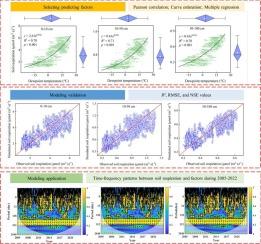黄土丘陵区土壤呼吸的多尺度动态与环境控制
IF 8
1区 环境科学与生态学
Q1 ENVIRONMENTAL SCIENCES
引用次数: 0
摘要
准确估算土壤二氧化碳(CO2)通量的时空变化对理解气候变化对土壤碳循环的影响至关重要。然而,尽管气象站的扩展和改进,很少有统计模型利用气象数据预测土壤呼吸(SR),特别是在深层土壤中。为此,本研究探讨了气象资料能否有效预测0-10、10-50和50-100 cm深度的SR,并分析了2005-2022年中国黄土丘陵区SR与气象因子的时频关系。结果表明:(1)3种土壤深度内,决定系数范围为0.69 ~ 0.71,均方根误差范围为0.10 ~ 0.17,Nash-Sutcliffe效率系数范围为0.68 ~ 0.71。(2) 2005 - 2022年0 ~ 100 cm土壤深度CO2累计通量为10050.4 g·m−2。其中,0 ~ 10 cm的相对贡献率最高,达到72%,10 ~ 50 cm和50 ~ 100 cm次之,分别占17%和11%;(3)小波分析表明,SR具有明显的季节周期性。在0 ~ 10 cm、10 ~ 50 cm和50 ~ 100 cm土壤深度,低温与SR的间歇相关性最强。结果表明,基于露点温度的模式表征了SR的时间变化特征,低温对SR的影响显著。本文章由计算机程序翻译,如有差异,请以英文原文为准。

Multi-scale dynamics and environmental controls on soil respiration in the loess hilly region in China
Accurate estimation of the spatial and temporal soil carbon dioxide (CO2) flux is vital for understanding the impacts of climate change on the soil carbon cycle. However, despite the expansion and refinement of weather stations, few statistical models have predicted soil respiration (SR) using meteorological data, particularly in deep soils. Thus, this study explored whether meteorological data can effectively predict SR at depths of 0–10, 10–50, and 50–100 cm, and examined the time-frequency patterns between SR and meteorological factors during 2005–2022 in the loess hilly region in China. The results showed that: (1) Within the three soil depths, the coefficient of determination ranged from 0.69 to 0.71, the root mean squared error varied from 0.10 to 0.17, and the Nash-Sutcliffe efficiency coefficient varied from 0.68 to 0.71. This finding indicated that the model based on dewpoint temperature demonstrated satisfactory reproducibility in predicting SR. (2) Cumulative CO2 efflux from 2005 to 2022 recorded 10,050.4 g·m−2 at 0–100 cm soil depths. Among these depths, the relative contribution of CO2 release was highest at 0–10 cm soil depth, reaching 72 %, followed by 10–50 cm and 50–100 cm, accounting for 17 % and 11 %, respectively; (3) Wavelet analysis revealed that SR exhibited discernible seasonal periodicity. Low temperature displayed the strongest intermittent correlation with SR in the 0–10, 10–50, and 50–100 cm soil depths, respectively. Those results show that the model based on dewpoint temperature characterizes the temporal variation in SR and demonstrates that low temperature significantly impacts SR.
求助全文
通过发布文献求助,成功后即可免费获取论文全文。
去求助
来源期刊

Science of the Total Environment
环境科学-环境科学
CiteScore
17.60
自引率
10.20%
发文量
8726
审稿时长
2.4 months
期刊介绍:
The Science of the Total Environment is an international journal dedicated to scientific research on the environment and its interaction with humanity. It covers a wide range of disciplines and seeks to publish innovative, hypothesis-driven, and impactful research that explores the entire environment, including the atmosphere, lithosphere, hydrosphere, biosphere, and anthroposphere.
The journal's updated Aims & Scope emphasizes the importance of interdisciplinary environmental research with broad impact. Priority is given to studies that advance fundamental understanding and explore the interconnectedness of multiple environmental spheres. Field studies are preferred, while laboratory experiments must demonstrate significant methodological advancements or mechanistic insights with direct relevance to the environment.
 求助内容:
求助内容: 应助结果提醒方式:
应助结果提醒方式:


